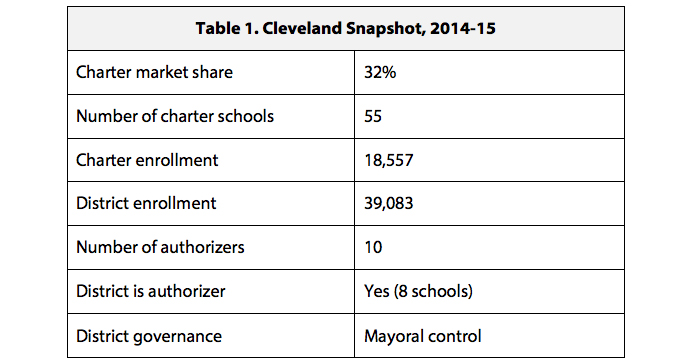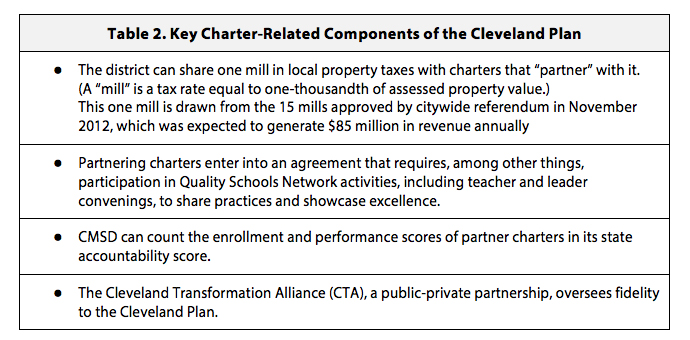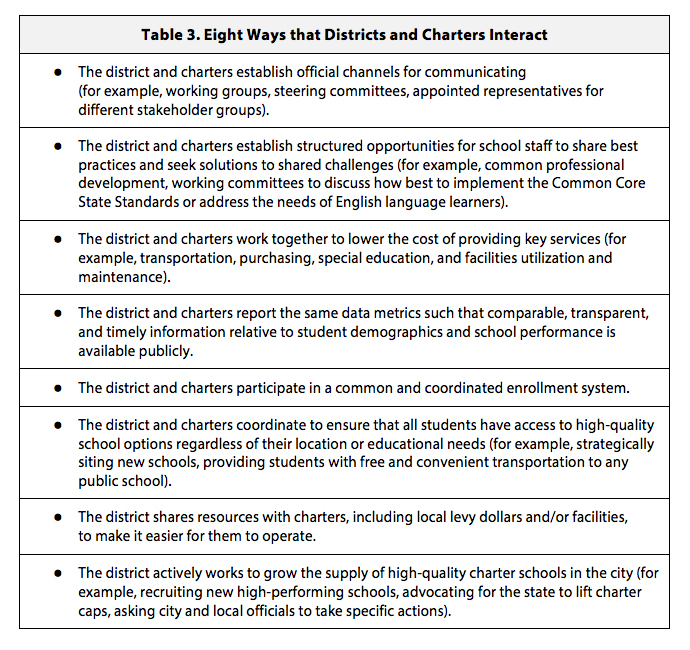
Over the past 25 years, charter schools have grown from a ragtag insurgency into a serious force in U.S. K–12 education. According to the National Alliance for Public Charter Schools, charters serve nearly three million children across the country and enroll more than 20 percent of students in several dozen cities. In most places, urban school districts aim to contain charters, but in a small but growing number of cities, the charter sector has become a serious educational player, too large and influential for the prevailing power to ignore. In such cities, districts and charters have sometimes responded by “engaging” with one another—that is, by collaborating or coordinating in pursuit of a common goal or to address practical challenges.
The Case for (and Against) Engagement
District-charter engagement has the potential to serve many interests. It offers districts the opportunity to achieve greater operational efficiency and share the burden of providing equitable access to all students. It offers charters the possibility of faster growth and greater access to district resources. And it offers families the benefits of an education landscape where the district and charter sectors pool their resources and expertise to advance the shared mission of providing all students access to an excellent school.
Not all forms of district-charter engagement are productive, however. Many districts may hesitate to engage with charters given the threat they pose to district enrollment and, as a result, to funding. Charter leaders can also have reason for caution because engagement can easily become a guise for imposing burdensome rules and regulations that undermine the very autonomies that make charters different and that contribute to their appeal and success.
Nonetheless, in cities with large and growing charter sectors, engagement of some kind has become necessary. In a recent study for the Thomas B. Fordham Institute, we examined these evolving relationships in five cities–Boston, Cleveland, Denver, the District of Columbia, and Houston. Although engagement looked markedly different in each city, we found that a common set of factors encouraged or impeded it. In every city, a trigger event, the persistence of leaders and other influencers, and the presence of conditions that give districts a stake in charter success or create competitive pressures have molded how the sectors do and do not interact with one another.
Here we describe how and why district-charter engagement happens, as well as its implications, by examining Cleveland, a city where the threat of a state takeover and the need to pass a new tax levy led the mayor and the district he oversaw to reach out to high-performing charters as part of his reform plan.

What District-Charter Engagement Means in Cleveland
In the 2014-15 school year, the Cleveland Metropolitan School District (CMSD) enrolled approximately 39,000 students while charters served more than 18,000 (see Table 1). Cleveland, a former manufacturing power, and its school district had seen better days: In the 1960s, nearly 150,000 students attended a CMSD school. Over time, though, a declining economy and white flight led many families to leave the city. In addition, the charter sector drew a growing share of the remaining public school students. Meanwhile, student performance had earned the district an “F” from the state for several consecutive years, and CMSD’s debt totaled tens of millions of dollars.
It was against this backdrop that city and state policymakers adopted the “Cleveland Plan” to transform the city’s schools. Although charters were just a small part of the initiative, most of the current district-charter engagement efforts stem from it. Key components of the plan are highlighted below, in Table 2.

Most notably, high-performing charters that formally partner with the district can receive a small share (1 mill) of the district’s levy dollars, whereas previously they received none. For the 2014–15 school year, 17 partner charters received approximately $4 million, parceled out among them in proportion to their enrollment. In exchange, CMSD can include the performance results of partnering charters in its state accountability score. In addition, these charters participate in the Cleveland Quality School Network (where they share best practices and collaborate on shared challenges), and they administer a student survey (the Conditions for Learning survey) each year. Partner charters also have access to the professional development that CMSD offers.
CMSD is also engaging with charters in a handful of other ways. For example, the Cleveland Plan established official channels for communicating through the Cleveland Transformation Alliance, a public-private partnership that oversees fidelity to the plan. In addition, several charters in the Breakthrough Charter Schools network—one of the city’s largest and most successful charter networks—have bought or leased school buildings from the district. In 2014, Cleveland also became a “compact” site as part of a Bill & Melinda Gates Foundation initiative seeking to broker healthy relationships between the sectors, although participants only signed the compact in December 2015.
…And What Engagement Does Not Mean
Although promising, and in some ways groundbreaking, district-charter engagement in Cleveland is still pretty minimal compared with other districts. As shown below in Table 3, our research identified eight ways that districts and charters interact across the country.

The majority of these activities are mostly, or entirely, absent in Cleveland. For example, the sectors have not worked together to lower transportation costs as they have in Boston. The Cleveland Transformation Alliance maintains a website that includes school performance data, community ratings, and other logistical information for each school in the city, but there is not a common and coordinated enrollment system as in Washington, D.C. and other cities. And although the sectors identified “exploring how charters can address the needs of the lowest-performing district schools” as a focus of the city’s Gates compact work, they have not committed to enrolling proportional shares of special education students, like their counterparts in Denver.
Meanwhile, where the sectors have engaged in a particular activity, relatively few charters have been involved. For example, just 17 of the city’s 50+ charter schools partnered with CMSD as of the 2015-16 school year. And of those 17, ten are part of the Breakthrough Charter network, with which CMSD already had a strong relationship prior to the Cleveland Plan. Similarly, just a handful of schools, also all part of the Breakthrough Charter network, have been able to lease district buildings. This situation may be changing, however; more than half of the city’s charter schools have signed onto the new Cleveland compact supported by the Bill & Melinda Gates Foundation.
The result is that district-charter engagement in Cleveland is a sort of “cultural and economic exchange.” The two sectors share some instructional practices. The district gets to count a small group of charters in its accountability score, and those charters get a share of local levy dollars. There’s mutual benefit in the arrangement, but not a great deal of engagement at the present time.
Five Factors that Explain Engagement in Cleveland
Engagement presents potential benefits—for charters, districts, and the public. At the same time, it poses risks for all parties. In particular, a growing charter sector threatens traditional districts by competing with them for students and funding, whereas teaming up with a district may threaten a charter sector’s valuable autonomy.
So, given the risks, how did CMSD and Cleveland charters come to engage at all? And on the flipside, why hasn’t more happened? Five factors stand out.
CMSD Had a Push
Districts and charters generally maintain their distance until and unless they find it in their interest to reach out and interact, and this often occurs only when some new event or development pushes them to do so. Such was the case in Cleveland, where things did not look good leading up to the passage of the Cleveland Plan. At the time, the district faced a deficit of $65 million for the 2012–13 school year and was one “F” rating away from a potential state takeover, which newly elected Republican Governor John Kasich was eager to initiate. District and city leaders were compelled to do something radically different as a matter of survival.
Bold Leadership Paved the Way
Ultimately, district leaders—including the superintendent, school board, and, in some places, the mayor—must demonstrate strong leadership if engagement is to occur. In Cleveland, Mayor Frank Jackson played a key role in encouraging greater district-charter engagement. To avoid bankruptcy, the district needed more funds. But with a third of the city’s kids attending charters, the odds of passing a levy without the support of charter parents seemed slim. In response, the architects of the Cleveland Plan included the provision to share 1 mill of the city’s new tax levy with charter schools that formally partnered with CMSD. Then, Mayor Jackson (who effectively controlled the district) began selling the Cleveland Plan to both politicians and constituents, ultimately securing the support of the governor, state legislators, and influential local charter supporters. As one interviewee explained, “The Cleveland Plan was the last best chance to change Cleveland, and Mayor Jackson was the lead champion out front on all of it.”
At the same time, Breakthrough Charter Schools encouraged its parents to support the levy and was among the first to partner with CMSD once the Cleveland Plan passed.
Outside Influencers Primed the Pump
A range of stakeholders, including foundations, advocacy organizations, politicians, unions, parents, and the business community, can support or discourage engagement. In Cleveland, these groups have largely supported it. For example, a business leader who was close to the mayor pushed for the Cleveland Plan to support excellent charter schools. Also, representatives from two influential local foundations that had long been involved in Cleveland’s school reform efforts shared their expertise, created opportunities for the mayor and others to learn from other cities, and helped frame the legislative debate.
Once the plan was complete, several state politicians proved key to its legislative success. For example, after the plan stalled in the legislature, Governor Kasich offered his public support to the mayor, appearing at press conferences with him and even asking members of his church to pray for all involved to “find the courage to support Mayor Frank Jackson.” Several state lawmakers from both parties also supported the plan, even as it (and they) were criticized. As the Plain Dealer editorial board wrote, “Jackson had plenty of odd bedfellows.…Legislative supporters on both sides of the aisle braved brickbats from charter school operators and unions.”
Both Sides Had Skin in the Game–But Only a Bit
Districts and charters are more likely to engage when they have a stake in the others’ success. The Cleveland Plan offered that, allowing CMSD to benefit from the high performance of partnering charters by including their results in the district’s accountability score and giving some charters access to levy funds. But a slight performance bump is not a particularly compelling incentive for a district to engage in the most demanding types of activities, such as sharing facilities or advocating for policy changes in support of charter growth and sustainability.
That sort of deeper engagement will likely require Cleveland’s charters to offer more as well, such as committing to share the responsibility of serving the city’s special education students or working with the district to turn around its chronically low-performing schools. So far, charters in Cleveland haven’t shouldered much of this weight, leading some supporters of the Cleveland Plan to call for more. But just like the district, charters have little incentive to step up in these ways, especially given the deep-rooted distrust some operators have of the district going back several administrations.
Competition Hasn’t Compelled Deeper Engagement
A growing charter sector exerts financial, logistical, and academic pressures on the district. The existence of these pressures is fairly predictable, but their impact on district-charter engagement is not.
In Cleveland, CMSD must certainly compete with charters for students and funding. But most charters have not outperformed the district. According to a 2015 study on urban charter schools conducted by CREDO, more than half of charters in the city demonstrated achievement growth that was comparable to or significantly worse than the district. Consequently, CMSD initially had little interest in forming relationships, let alone sharing resources, with lower-performing charters, even though they draw students away. Indeed, charters’ mixed performance has influenced the ways in which CMSD has reached out—often with the goal of aligning with the highest-performing charters and isolating the lowest-performing ones.
The charter landscape in Cleveland further complicates how the district responds to competition there. Multiple authorizers sponsor dozens of schools, and CMSD has no obvious counterpart with which to engage and negotiate. CMSD must approach each school individually, making even the most basic kinds of engagement a considerable burden.
What’s Next for Cleveland
The city of Cleveland formally embraced charters as partners in public education when it adopted the Cleveland Plan. Moreover, it implemented a strategy that few other cities have been willing to consider: Sharing a portion of local property taxes with charters. Nonetheless, the current relationship between CMSD and its charter partners is largely transactional and limited to just a small slice of the sector. CMSD shares levy dollars with a group of charters, and those charters count in the district’s accountability rating and participate in a short list of activities.
But there is opportunity to build on the existing “cultural and economic exchange.” CMSD and Cleveland’s charters could benefit by sitting down together, identifying the issues they want or need to work through, and developing a plan for doing so. It is in this vein that CMSD is participating in the Gates compact work. However, breaking through the logistical hurdle of a fractured charter sector, building strong relationships where none generally exist, and convincing the sectors that it may be in their best interest–as well as their students’–to work together is no small task in Cleveland.
Implications for Other Cities
Done well, district-charter engagement can produce many benefits for many recipients. It can help districts manage the operational and financial challenges that accompany a growing charter sector and meet the needs of their students. It can give charter schools increased access to facilities and local tax dollars. It can provide taxpayers with more efficient education systems. And it just might increase the supply of great schools.
But in a world where organizations make decisions based on self-interest, it is rare that events, people, and conditions align in ways that make significant engagement worth the risk. Just as relations between nations advance in fits and starts, with episodes of exchange, détente, isolationism, and war, we can expect all of the above as charters and districts play out their own form of geopolitics. As Cleveland illustrates, when the sectors engage at all, they often do so in ways that fall short of their own goals. So long as both sectors continue to exist side by side, however, policymakers must continue to search for a way to foster a more productive coexistence.
Daniela Doyle and Christen Holly are consultants with Public Impact, where Bryan Hassel is co-director.


